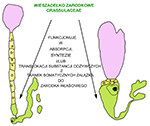Embryogenesis in Crassulaceae: structural aspect of suspensor development
DOI:
https://doi.org/10.18388/pb.2021_406Abstract
The suspensor in the majority of angiosperms is an evolutionally conserved embryonic organ functioning as a conduit that connects ovule tissues with the embryo proper for nutrients and growth regulators flux. In this article the present knowledge on the embryo-suspensor ultrastructure and function in representatives of Crassulaceae genera: Sedum, Jovibarba, Sempervivum, Aeonium, Monanthes, Aichryson and Echeveria. The role of the suspensor in the transport of nutrients from the tissues of the ovule to the proper embryo is confirmed by the structure of the basal cell, especially the nature of the micropylar part of its wall, the "transfer wall". The basal suspensor cell is a site of intense metabolic activity. The special attention is paid to the plasmodesmata. The correlation between types of suspensors and structure of plasmodesmata was investigated. Final conclusions are given and the presented data summarized.

Published
Issue
Section
License
Copyright (c) 2021 Advances in Biochemistry

This work is licensed under a Creative Commons Attribution 4.0 International License.
All journal contents are distributed under the Creative Commons Attribution-ShareAlike 4.0 International (CC BY-SA 4.0) license. Everybody may use the content following terms: Attribution — You must give appropriate credit, provide a link to the license, and indicate if changes were made, ShareAlike — If you remix, transform, or build upon the material, you must distribute your contributions under the same license as the original. There are no additional restrictions — You may not apply legal terms or technological measures that legally restrict others from doing anything the license permits.
Copyright for all published papers © stays with the authors.
Copyright for the journal: © Polish Biochemical Society.



